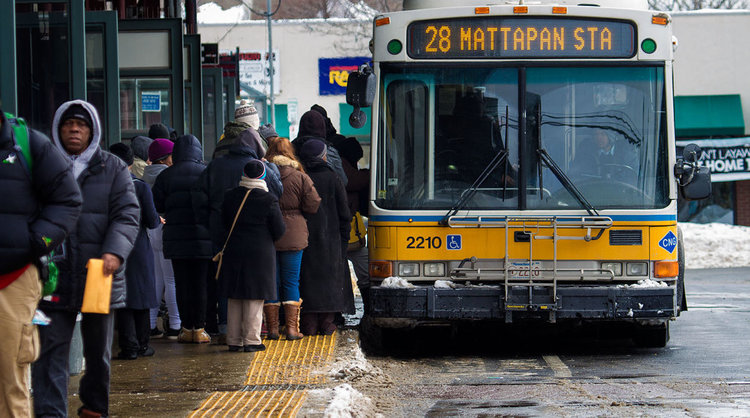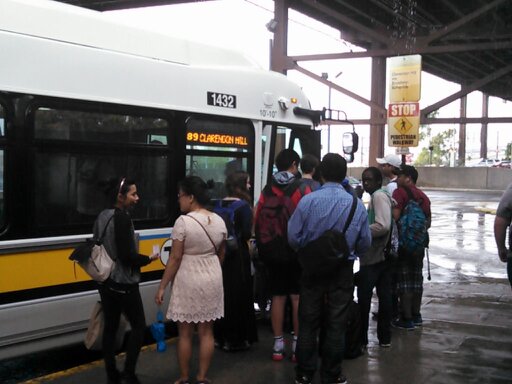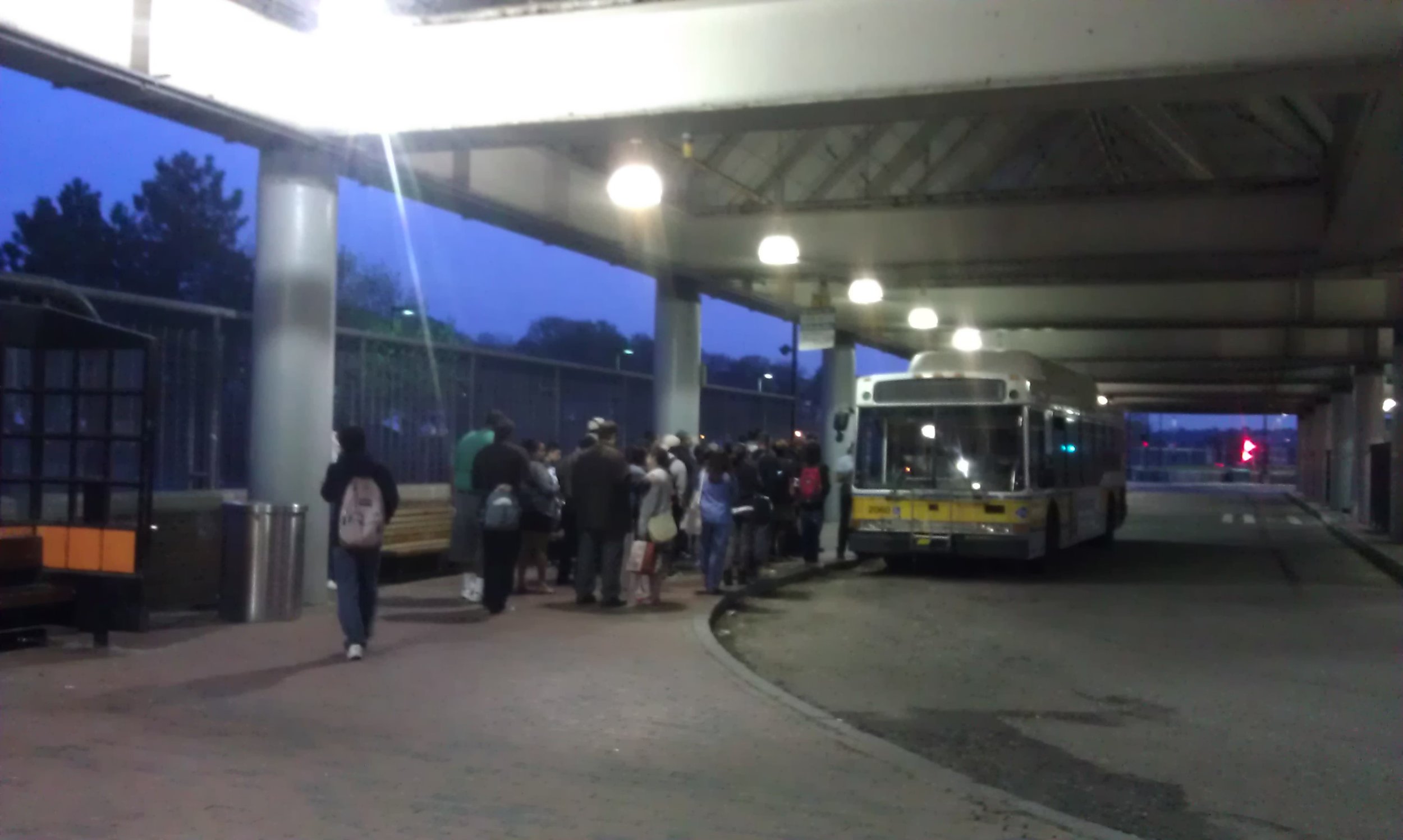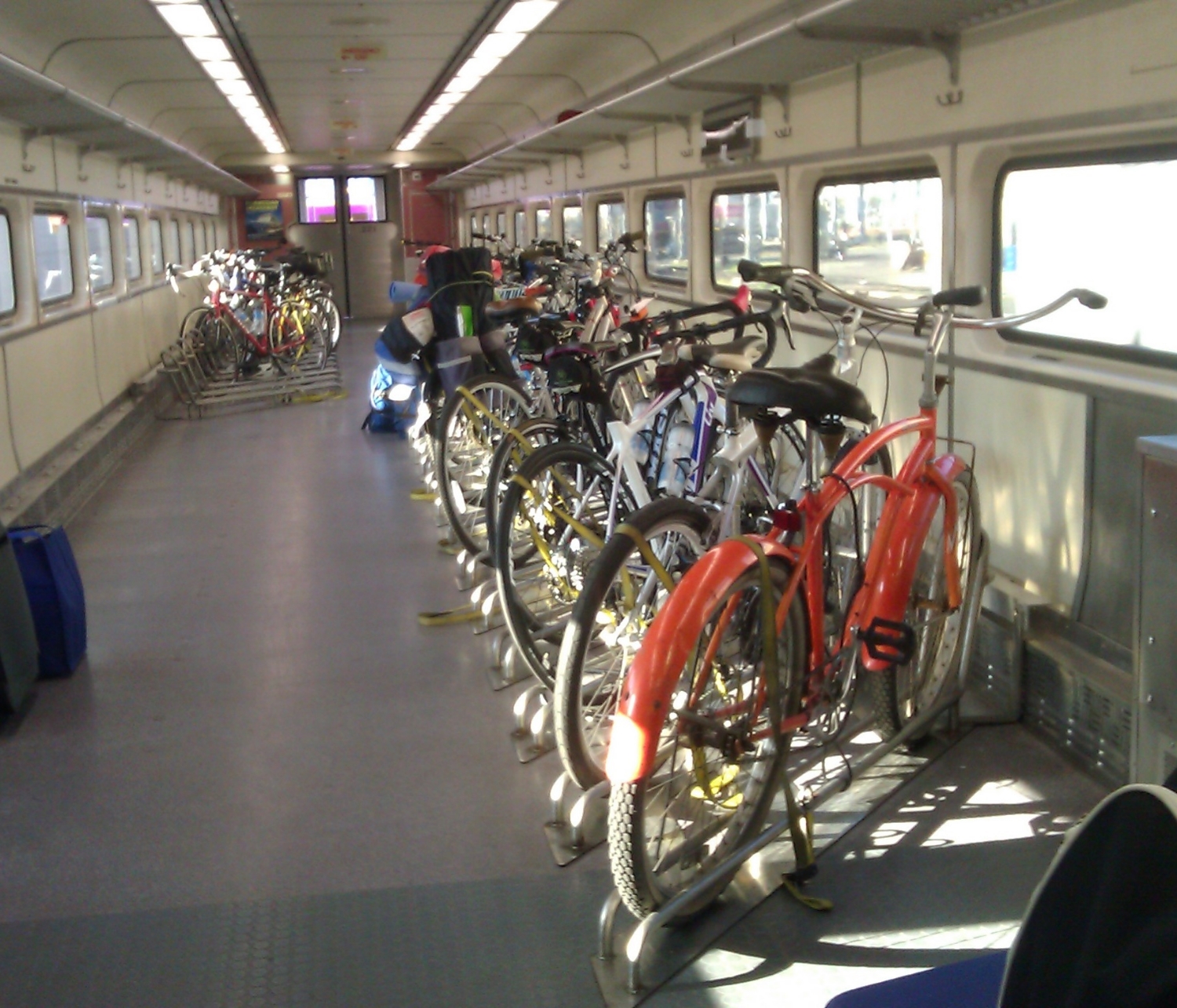https://commonwealthmagazine.org/opinion/5-ways-to-make-buses-more-reliable/
Too many buses show up too early, too late, or not at all
THE REMARKABLE RESILIENCE of bus ridership through even the worst months of the pandemic has underscored the critical importance of this surface transportation mode to provide access to jobs and opportunities, especially for those not privileged to be able to work from home. Buses disproportionately carry low-income, essential workers who tend to have inflexible work hours and locations. For those with other options, a single bad experience can cause them to avoid using buses, furthering a cycle of low ridership and increased traffic congestion.
That’s why it is essential that MBTA bus services become more reliable. Too many buses show up too early, too late, or not at all. Buses often bunch together as some get stuck in traffic and leave long gaps in between, forcing riders to wait up to three times as long as the schedule indicates, only to be met with an overcrowded bus and then another one (or two or three) right behind it.
While the MBTA is currently in the process of redesigning the bus network, which should include major reliability improvements, we don’t have to wait until next year to start making progress. The challenge of keeping buses on time in dense urban areas with variable ridership and traffic conditions is not unique to Boston, so we can look to transit industry best practices to ensure more buses show up on time and keep moving. Here we discuss a few essential changes to achieve even spacing of buses and minimize waiting time and overcrowding.
Headway maintenance
Busy frequent routes in mixed traffic tend to have variable travel times that make schedules hard to follow. There are often enough buses to carry the number of passengers arriving each hour, but the uneven spacing between buses results in overcrowding and is an inefficient use of resources.
As an effective way to deal with these issues, the MBTA should deploy a “headway maintenance” operation where buses simply stay 10 minutes apart. This makes service easy to understand and use and keeps wait times short, so that transfers are easy. Headway maintenance would also prevent the worst overcrowding, which is typically caused or worsened by bunching and long gaps that are common today. Rapid transit lines (and the shuttle buses that fill in for them during planned shutdowns) already do this: instead of having scheduled times, dispatchers work to ensure the spacing (headway) between trains is consistent and low enough so nobody has to wait too long. Implementing this on buses would mean that every operator is responsible for monitoring the spacing ahead and behind them using computer aids and managing their speed, and thus would be very low cost. (This practice could also be adapted to trains to smooth out arrival times and reduce instances of overcrowding and stop-and-go trips, especially on the Green Line.)
Pulse points
In less dense areas where service is less frequent, there is another option for keeping wait times short: the pulse. A pulse point is a central hub where several routes all arrive and depart at around the same time, so that people can transfer between all the routes conveniently. An example of where this could work well is Central Square in Lynn, which is a hub for most of the bus routes serving the North Shore. There is already regional rail service nearly every half hour, with trains arriving from Boston at 25 and 55 minutes past every hour and trains departing for Boston at 4 and 34 minutes after the hour with only a few gaps. There are also five bus routes that terminate at Lynn and run just about hourly, together with the Number 455 bus which passes through on the way from Wonderland to Salem every half hour and the relatively frequent 441/442 buses toward Wonderland or Marblehead.
What would a pulse schedule look like at Lynn? Without changing the rail schedule at all, the 455 bus could pass through on the hour and half hour in both directions, with the other buses arriving at 5 minutes beforfe the hyour and departing 5 minutes after the hour. This allows riders to connect from the terminating routes such as the 426, 429, 435, and 436 to trains going to Boston or to the 455 bus to Wonderland and Salem. It allows riders coming from Boston on the train or from Wonderland on the 455 bus to connect to those routes, with only a 5-10 minute wait. Likewise, it allows connections between the train and the 455 bus, allowing riders headed for the outer part of the route past Lynn to save a considerable amount of time compared to taking the Blue Line and changing to the bus at Wonderland.
These connections can be made even better if the schedule of the trains is adjusted to make the inbound and outbound trains arrive closer together, which would allow for connections to/from trains in both directions. Early morning, evening and weekend buses could also wait an extra few minutes to depart if any route is running a little late.
Pulse systems could be applied in other places where MBTA or Regional Transit Authority bus routes meet at a station, including Waltham (MBTA), Fitchburg (MART), or Framingham (MWRTA), or anywhere two or more bus routes meet. Indeed, Brockton Area Transit (BAT) in Brockton already operates a pulse system centered on the BAT Center across the street from the Brockton station, but the MBTA train service isn’t coordinated with the buses.
Dedicated bus lanes
Third, in order to maintain even spacing between buses – which makes them more reliable – and ensure the success of pulse systems, the issue of traffic congestion must be addressed. The number one reason why buses are late and run invariably between destinations is because they are stuck in traffic. While various strategies can be used at the street or vehicle design level to keep buses moving, the most effective is dedicating road space to buses.
Dedicated bus lanes, a key element of bus rapid transit, allow buses to travel without obstruction with the same fluidity as trains, thus making them inherently more reliable. When riders wait to board a bus at point A, they know exactly how long it will take to arrive and then reach point B because it will not be subject to the variability of traffic. It will also be a smoother, more comfortable ride that is less subject to crowding because buses are able to complete their runs more quickly and provide more trips. A bus that is not in traffic is a faster, safer, more reliable bus.
Metro Boston has already experienced the benefits of dedicated bus lanes, with over 14 miles and counting of the lanes in communities ranging from Lynn to Everett to Roslindale. These bus lanes have not only shaved valuable minutes from bus trips; they have made the buses far more reliable. When combined with other bus rapid transit elements such as level and all-door boarding, transit signal priority, and center-running lanes, these benefits become amplified.
Dedicated bus lanes are not just good for bus riders, they are good for all users and overall traffic flow of the road. By alleviating the conflict between buses and other vehicles as they attempt to merge in and out of moving traffic at bus stops, bus lanes can lend themselves to the improvement of overall traffic flow, decreasing idling and minimizing dangerous emissions on the corridor. They can also create opportunities for shared bus-bike lanes which many of the Boston area bus lanes have incorporated. With dual-side door buses (that is, buses with doors on both sides), the operational flexibility of the road with bus lanes is significantly increased because buses are no longer restricted to curbside boarding on the right and that space is opened up for other critical uses like protected bike lanes, parklets, delivery and drop off zones, or outdoor dining.
Transit signal priority
Traffic signals play a very important role in bus and light rail reliability. While there are many thousands of traffic signals in Greater Boston, only a small number of locations are responsible for most cascading delays and reliability impacts.
Signal priority is the simple act of ensuring that transit vehicles are given a green light as they approach an intersection. This technology is inexpensive and can keep buses moving with minimal impacts to pedestrians and other vehicle users.
With a small one-time investment focused on high volume bus corridors, station busway access points, and a few dozen hotspots, bus reliability will greatly improve.
Intersections which delay transit service should be prioritized for signal upgrades. Since we can’t install this technology everywhere right away, as a general policy, all signal cycles should be kept simple and short so that they are easy to understand and nobody has to wait too long. Short signals minimize transit delays while also limiting the need for extra vehicle lanes to act as car storage, which further improves safety for transit riders and other pedestrians. Transit signal priority is often only needed at the longest and most complicated signals, where it is best complemented by a queue jump lane – a very short bus lane – that allows buses to bypass traffic waiting for the signal, access the bus stop, and merge back into the traffic flow.
All door boarding
The time that a bus spends at the station or bus stop to let passengers on and off – known as “dwell time” – is one of the most overlooked factors impacting bus service reliability. Because fare collection is only possible through the front door of MBTA buses today, the process of boarding passengers can often be lengthy, not to mention unpleasant, with passengers frequently lined up or bunched together in all weather, waiting to board one-by-one and tap their Charlie Cards or insert cash at the front door farebox.
A 2015 study by ITDP found that 40-70 percent of delays on MBTA key bus routes happen at bus stops, even more than delays caused by congestion or intersections. Demonstrations of “all door boarding”, where passengers are able to board all at once through both the front and back doors, have shown travel time reductions up to 30 percent as well as notable improvements to bus reliability – because the buses were able to leave the station on time – and overall rider experience.
All door boarding is most effective in combination with off-board fare collection or no fare collection at all. While controversial in its application, the MBTA’s Fare Transformation project seeks to enable all door boarding through placement of fare card validators at both front and back doors, thus enabling a limited version of the benefits offered by this bus improvement. A more effective strategy is to place validators at bus stops, especially at stations where boarding volumes are high.
A frequent, reliable and integrated transit network is what people want, need and deserve. If “moving more people in fewer vehicles” is truly a goal we embrace as a Commonwealth, then prioritizing reliable, efficient bus service is imperative. To support public health and economic recovery and make our region more resilient in a post-pandemic era of climate change, the focus of our streets must change from movement and storage of vehicles to movement and activity of people. Similarly, the operation of bus service must shift to focus on minimizing waiting and travel time by ensuring frequent service with easy, predictable connections, so that everyone can participate fully in their communities.
Jeremy Mendelson is a co-founder of and lead bus service planner for TransitMatters; Julia Wallerce is Boston program manager for the Institute for Transportation and Development Policy, and Acardy Goldmints-Orlov is a member of TransitMatters.













